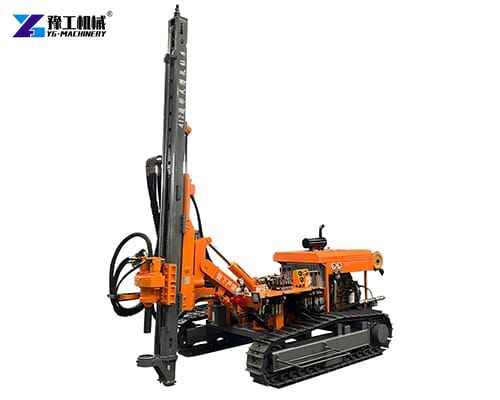DTH drilling rig, short for Down-The-Hole drilling rig, is a cornerstone of modern drilling technology. Renowned for its efficiency, precision, and versatility, this equipment has revolutionized industries ranging from mining and construction to geothermal energy exploration. It has become indispensable in mining, construction, geotechnical engineering, and water well projects. DTH drilling machine operates on a straightforward yet highly effective principle. A pneumatic or hydraulic hammer, positioned directly behind the drill bit, delivers rapid percussive blows to crush rock formations. Simultaneously, compressed air or fluid is injected through the drill string to flush out debris, ensuring a clean borehole. This dual-action mechanism enables DTH rigs to achieve remarkable penetration rates even in complex rock conditions.
How Does DTH Drilling Work?
The core principle of the DTH drilling rig involves a percussion system located at the bottom of the drill string. Here’s a simplified explanation of the process:
A high-pressure air compressor supplies compressed air to the drilling rig
The air passes through the drill pipes to power the DTH hammer
The hammer strikes the drill bit, which in turn breaks the rock into small chips
These rock fragments are flushed out of the hole by the exhaust air coming from the hammer
As the drilling progresses, additional drill pipes are added to deepen the hole
Because the hammer is located directly behind the drill bit, energy loss is minimized, and the force is transmitted more efficiently than in top-hammer systems.
Applicable Scenario of DTH Drilling Machine
A. Mining and Quarrying
Blasthole Drilling: Prepares holes for explosives in open-pit mines, enhancing fragmentation efficiency.
Exploration Drilling: Facilitates core sampling to assess mineral deposits.
Trenching and Tunneling: Supports underground mining operations by creating access shafts.
B. Construction and Infrastructure
Foundation Drilling: Prepares holes for piles, micropiles, and anchors in building foundations.
Slope Stabilization: Installs rock bolts and drainage systems to prevent landslides.
Road Construction: Excavates for road cuts and embankments in rocky terrain.
C. Water Well and Geothermal Energy
Deep Well Drilling: Penetrates hard rock formations to access groundwater or geothermal reservoirs.
Aquifer Development: Enhances groundwater flow through strategic borehole placement.
Advantages of DTH Drilling Rig
Superior Penetration Rates
By concentrating impact energy directly at the bit, DTH rigs achieve faster drilling speeds than rotary or top-hammer rigs, especially in hard rock. This reduces project timelines and labor costs.
Enhanced Precision
The system’s stability and control mechanisms enable operators to drill straight, accurately aligned holes—critical for blasting efficiency and structural integrity in construction.
Reduced Environmental Impact
Efficient debris removal and lower energy consumption compared to conventional rigs result in smaller carbon footprints. Additionally, minimized vibration and noise make DTH rigs suitable for urban areas.
Choosing the Right Down the Hole Drilling Rig
Selecting the right DTH drilling rig depends on several factors:
Drilling Depth and Diameter
Determine the required hole depth and diameter to choose a rig with adequate power and bit size compatibility.
Geological Conditions
Hard rock formations require higher impact energy and more durable drill bits.
Compressor Size
Air volume and pressure capacity must match the hammer and drill bit requirements.


